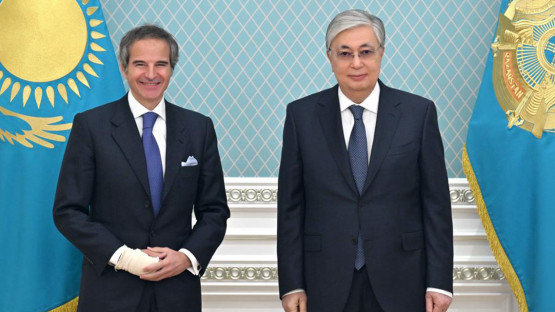The Republic of Kazakhstan and the IAEA have agreed to strengthen collaboration in the peaceful applications of nuclear science and technology, following IAEA Director General Rafael Mariano Grossi’s visit to the country this week.
Mr Grossi met with Kazakhstan President Kassym-Jomart Tokayev and senior leaders in the country, and visited the world's only Low Enriched Uranium (LEU) Bank — a physical reserve of LEU for eligible IAEA Member States in case the supply of LEU to a nuclear power plant is disrupted due to exceptional circumstances that disable the securing of the fuel from the commercial market or any other supply arrangement. The LEU Bank is located in Oskemen in Kazakhstan, and is owned and controlled by the IAEA.
In Astana, the county’s capital, Mr Grossi thanked President Tokayev for the productive bilateral relationship between the Agency and Kazakhstan, which became a member of the IAEA in 1994. He also thanked the President for his support towards the IAEA’s efforts to ensure safety and security of Ukraine’s nuclear power plants, including Zaporizhzhya Nuclear Power Plant, the largest in Europe, during the current military conflict.
During his visit, Mr Grossi met with Minister of Energy, Almasadam Satkaliyev, with whom he signed Kazakhstan’s Country Programme Framework 2023-2028, to ensure closer interaction between the Agency and Kazakhstan in areas related to the development of nuclear power infrastructure, nuclear and radiation safety, food security and nuclear medicine. Country Programme Frameworks are mutually agreed priority development needs and interests between the IAEA and individual countries, to be supported through technical cooperation activities.
Mr Grossi also met with Kazakhstan’s Minister of Health, Azhar Giniyat, where the two discussed potential cooperation on two recent IAEA initiatives related to increasing access to cancer care — Rays of Hope — and protection against zoonotic diseases — ZODIAC.
“The bilateral relationship between the IAEA and Kazakhstan is rich and diverse,” Mr Grossi said, highlighting the IAEA’s support to the country in the development of nuclear medicine and pandemic relief efforts. He added that nuclear power would be central to Kazakhstan’s plans to achieve carbon neutrality.
Earlier this month, Kazakhstan received an IAEA mission to review progress of the country’s nuclear infrastructure development, as the Ministry of Energy has proposed the potential reintroduction of nuclear power to reduce the country’s reliance on fossil fuels, diversify its energy mix and reduce CO2 emissions. The country currently operates research reactors as well as several other nuclear installations related to the front end of the nuclear fuel cycle, including uranium mining, and has the second largest uranium reserves in the world with 14 per cent of the total.
In Oskemen, around 950km east of Astana, Mr Grossi visited the IAEA Low Enriched Uranium (LEU) Bank, which became operational in 2019. He thanked Kazakhstan for “generously and professionally” hosting the LEU Bank at its Ulba Metallurgical Plant. The LEU Bank is a physical stock of 90 metric tons of low enriched uranium hexafluoride suitable to make fuel for a typical light water reactor, the most widely used type of nuclear power reactor worldwide. The LEU contained within the Bank can be used to produce enough nuclear fuel to power a large city for three years.





